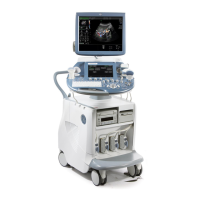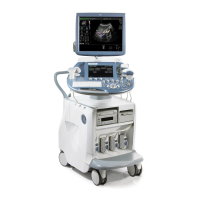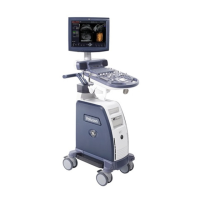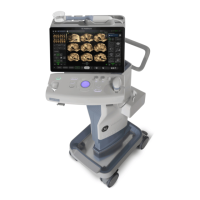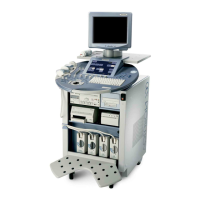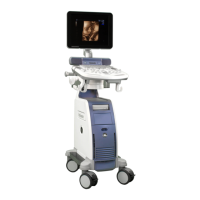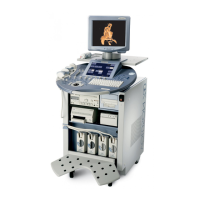GE HEALTHCARERAFT VOLUSON E8 / VOLUSON E6
D
IRECTION KTD102576, REVISION 7 DRAFT (AUGUST 23, 2012) SERVICE MANUAL
5-8 Section 5-2 - General Information
5-2-1-3-3 Bi-Directional Angio (HD-Flow Mode)
Directional Power Doppler is a Power Doppler mode incorporating the flow direction (much like
Color Doppler) into the displayed image. The focus of the settings for Directional Power Doppler is
for high spatial resolution and low artifact visibility, allowing vessels to be seen with less blooming
and finer detail.
5-2-1-3-4 Tissue Doppler
The Tissue Color Doppler Imaging is used for color encoded evaluation of heart movements.
The TD image provides information about tissue motion direction and velocity.
5-2-1-4 Pulsed (PW) Doppler
PW Doppler processing is one of two spectral Doppler modalities, the other being CW Doppler.
In spectral Doppler, blood flow is presented as a scrolling display, with flow velocity on the Y-axis and
time on the X-axis. The presence of spectral broadening indicates turbulent flow, while the absence of
spectral broadening indicates laminar flow. PW Doppler provides real time spectral analysis of pulsed
Doppler signals. This information describes the Doppler shifted signal from the moving reflectors in the
sample volume. PW Doppler can be used alone but is normally used in conjunction with a 2D image
with an M-line and sample volume marker superimposed on the 2-D image indicating the position of the
Doppler sample volume. The sample volume size and location are specified by the operator. Sample
volume can be overlaid by a flow direction cursor which is aligned, by the operator, with the direction of
flow in the vessel, thus determining the Doppler angle. This allows the spectral display to be calibrated
in flow velocity (m/sec.) as well as frequency (Hz). PW Doppler also provides the capability of
performing spectral analysis at a selectable depth and sample volume size. PW Doppler can be used
in combination with 2D and Color Flow modes.
5-2-1-5 3D Imaging
The Voluson E8 / Voluson E6 Ultrasound System will be used to acquire multiple, sequential 2D images
which can be combined to reconstruct a three dimensional image. These 3D images are useful in
visualizing three-dimensional structures, and in understanding the spatial or temporal relationships
between the images in the 2D sequence. The 3D image is presented using standard visualization
techniques, such as surface or volume rendering.
5-2-1-6 3D Data Collection and Reconstruction
2D gray scale images including Color Flow or Power Doppler information may be reconstructed.
The acquisition of volume data sets is performed by sweeping 2D-scans with special transducers
(called 3D-transducers) designed for the 2D-scans and the 3D-sweep.
2D ultrasound imaging modes are used to view a two dimensional cross-sections of parts of the body.
For example in 2D gray scale imaging, a 2 dimensional cross-section of a 3-dimensional soft-tissue
structure such as the heart is displayed in real time. Typically, the user of an ultrasound system
manipulates the position and orientation of this 2D cross-section in real time during an ultrasound exam.
By changing the position of the cross-section, a variety of views of the underlying structure are obtained,
and these views can be used to understand a 3-dimensional structure in the body.
To complete survey a 3-dimensional structure in the body, it is necessary to collect 2D images which
span a volume containing the structure. One way is to sweep the imaging cross-section by translating
it in a direction perpendicular to the cross-section. Another example method is to rotate the cross
section about a line contained in the cross section. The Voluson E8 / Voluson E6 Ultrasound System
uses the automated so called C-Scan for the motion perpendicular to automated B-scan. Once a
representative set of 2D cross-sections are obtained, standard reconstruction techniques can be used
to construct other 2D cross-sections, or to view the collection of the cross-sections as a 3D images.
